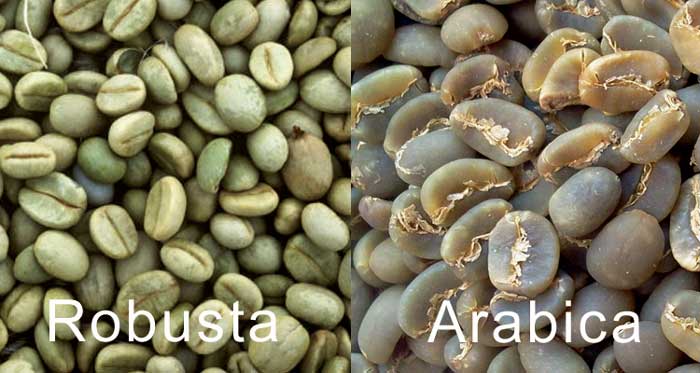Coffee
Difference Between Robusta Coffee and Arabica Coffee
In fact, many varieties of coffee trees grow throughout the world. However, there are two types of coffee that are best known and have many fans, namely Arabica and Robusta coffee. The following is the difference between Arabica and Robusta coffee that must be known by coffee lovers.
What’s difference between Robusta coffee and Arabica Coffee?
1. Age of Coffee
One thing that distinguishes Robusta and Arabica coffee is the age of the coffee itself. Arabica coffee beans are the first type of coffee ever consumed, while Robusta coffee was only discovered approximately 100 years after arabica.
So it’s no wonder that Arabica coffee is able to dominate the market share of up to 70% in the world.
2. Form of Coffee Beans
You can distinguish the two types of coffee by looking at the shape of the seeds. Arabica coffee beans tend to be larger and oval and flat, while Robusta coffee beans have a full round shape.
3. Caffeine Levels
For those of you who like to consume coffee to stay awake at night, drink Robusta coffee, because Robusta coffee beans have a caffeine content of 2.2 to 2.7%.
While Arabica coffee beans only have a smaller caffeine content than Robusta coffee beans, which is equal to 1.1% to 1.5%.
4. Fat and Sugar Content
Besides caffeine, the fat and sugar content of the two types of coffee beans are very different. Arabica has more fat and sugar than Robusta.
Arabica has a fat content of up to 60% and has 2 times more sugar content than Robusta.
5. The Aroma of Coffee
Because Arabica has higher acid content, Arabica has a fruit-dominated aroma, whereas Robusta has a nut-like aroma.
6. Taste of Coffee
The most basic thing, and really distinguishes the two types of coffee is the taste. Robusta has a higher caffeine content, so Robusta has a bitter taste like a burning tire and leaves a nutty taste at the end.
Unlike Arabica which tends to be sour and has a sweeter taste, not even a few that have a slight taste of fruits, chocolate and nuts.
7. Type of Presentation
Because Arabica coffee has a strong and sweet taste without the addition of any sugar, this coffee is more suitable to be served as a single origin coffee so that coffee connoisseurs can experience the original taste of Arabica coffee.
While Robusta coffee has a bitter taste, so it is more suitable to be used as an ingredient of esspresso blends. This type of serving is suitable for people who don’t like coffee because it will be added with milk and cream.
8. Plant Size
on to the taste and shape of the seeds, Robusta coffee and Arabica coffee can be distinguished by the size of the plant. The Robusta coffee plant has a larger leaf shape and size.
Robusta coffee plants are 2 times higher than Arabica coffee plants, so that Robusta coffee plants are able to reach 5 meters. While the Robusta coffee plant is only 2.5 – 5 meters high.
9. Chlorogenic Acid Content
Robusta coffee has 7 to 10% chlorogenic acid content, while Arabica coffee only has 5.5 – 8% chlorogenic acid content.
Chlorogenic acid has a bitter taste, so this acid is quite influential on the bitter taste that Robusta coffee has. In addition, this acid also has benefits to protect plants from pests.
10. Planting Area
Arabica coffee can only grow in a humid environment, not too hot and not too cold. Arabica coffee will flourish if planted on higher ground around 700 to 1,700 masl.
Countries that produce Arabica coffee beans types are Indonesia, Brazil, Mexico, Costa Rica, Ecuador, Colombia, Ethiopia, Burundi, Rwanda and many more.
In contrast to Arabica coffee beans, Robusta coffee beans can be planted at an altitude of 400 to 700 mpdl only. Countries that are famous for producing Robusta coffee beans are Vietnam, Brazil, Indonesia, India, Uganda, Malaysia, Madagascar and others.
11. Ease of Cultivation
In comparison, Robusta coffee is more easily cultivated than Arabica coffee. As explained earlier, Arabica coffee can only grow in damp environments and cannot survive extreme weather changes.
Another case with Robusta coffee beans that can withstand even the hot weather. Robusta coffee is also easier to develop, because it is more immune from pests and diseases thanks to its higher chlorogenic acid content.
12. Price of Coffee Beans
Because it is difficult to cultivate, it’s no wonder that the price of Arabica coffee beans tends to be more expensive. Not only is it difficult to cultivate, Arabica plants produce fewer coffee beans in a year than Robusta coffee beans
indonesiacoffees.com is robusta coffee bean supplier and arabica coffee bean supplier,n





